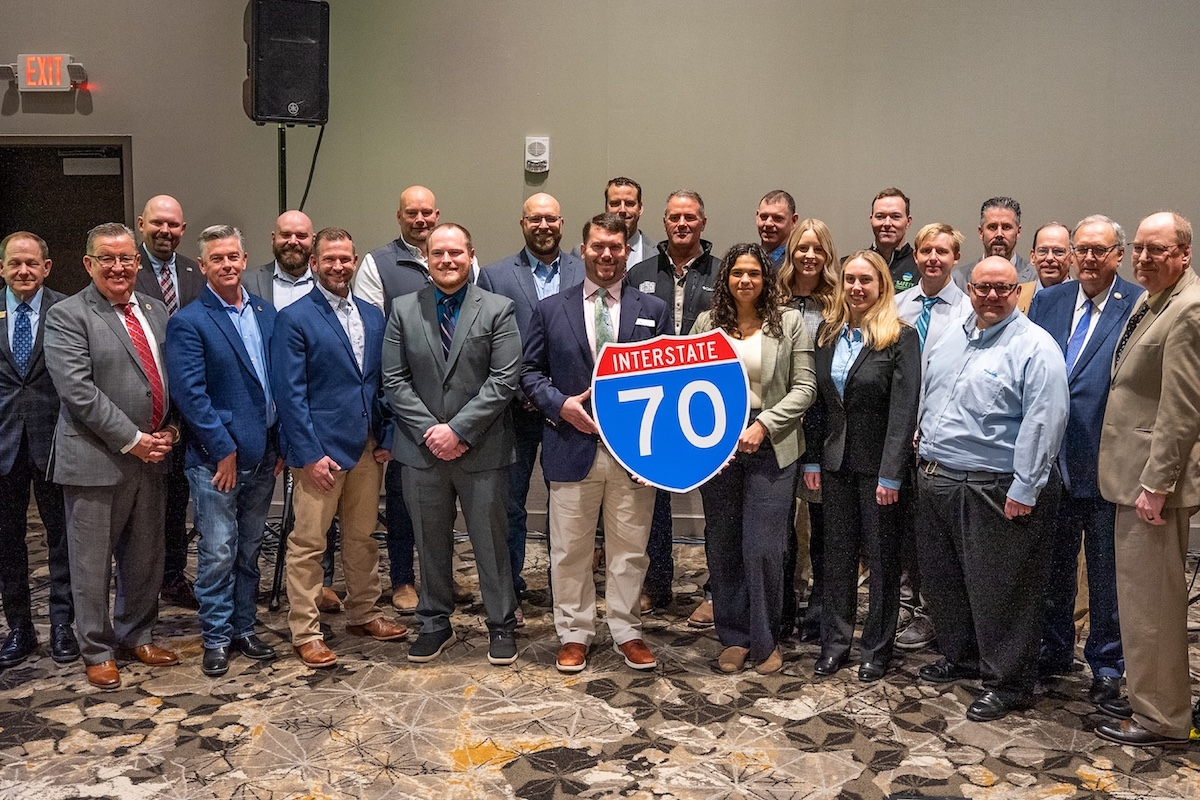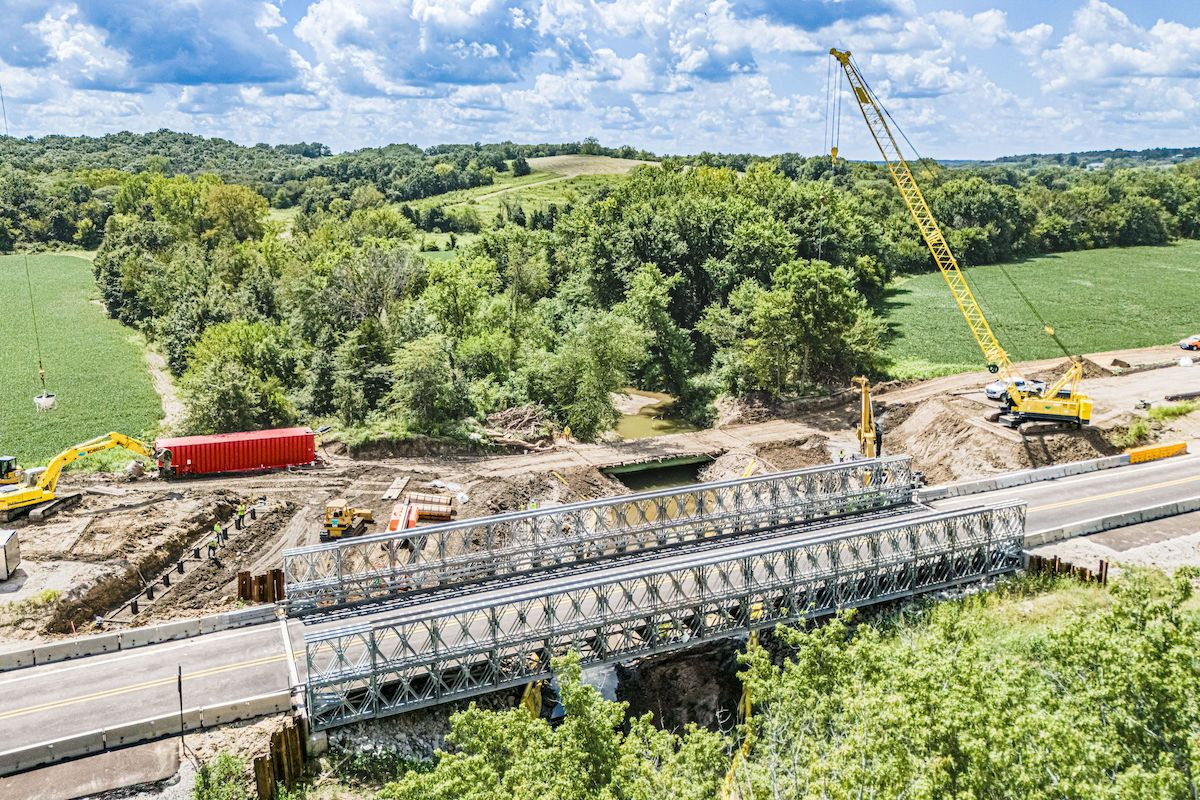Today, this portion of I-271 averages upward of 120,000 vehicles per day, with even higher traffic volumes during peak travel times. It ranked as one of Ohio’s worst-performing roadways in 2019, according to ODOT’s Traffic Operations Assessment Systems Tool, also known as TOAST, which is used to analyze highway operational performance annually.
“In 2013, the average daily traffic (ADT) high point was 141,480. Our forecast for 2037’s ADT high point is 164,030,” says Timothy Sturges, Area Engineer for ODOT District 12, which manages a tri-county region encompassing Cuyohoga, Geauga, and Lake counties.
According to Matt Luyster, a Project Engineer at Kokosing, crews worked on eight bridges within the project limits. Six existing bridges were reconstructed and widened, and another was completely demolished and rebuilt along a new alignment. The final structure, located at the intersection of I-480 westbound over I-271 northbound, is brand-new.
Southbound I-271 – at the south end of the express lanes – was also modified to accommodate a third travel lane, notes Michael Herceg, Bridge and Pavement Management Engineer for ODOT District 12. He adds that the project included associated lighting, signage, noise walls, concrete barriers, and drainage infrastructure as well.

| Your local Gehl Co dealer |
|---|
| Star Equipment LTD |
The project features approximately 20,000 tons of new asphalt pavement and 600,000 square yards of new concrete pavement. An estimated 119,000 square feet of bridge deck, 7,800 feet of median barrier, and 1.4 million cubic yards of earthwork were also required for construction. The new concrete pavement is expected to last approximately 50 years and the life span for the bridge decks is 50 to 100 years.
A 14-inch, non-reinforced concrete pavement was used for the area south of Miles Road. North of Miles Road, the existing asphalt overlay section is a composite system consisting of a 10-inch concrete base (existing), a 1.75-inch asphalt intermediate, and a 1.5-inch asphalt surface.
Kokosing set up an Erie Strayer portable batch plant to produce the concrete pavement, which was assisted by a Caterpillar 980 Loader and GOMACO GZ paving equipment. Examples of other heavy construction machinery used on the project include: Manitowoc 180 cranes; excavators ranging in size from Komatsu 228 to 490; Caterpillar dozers (D6Ns, D6Ts and D8s) equipped with GPS systems; John Deere 650 dozers and 624 loaders; and Vermeer 758 and 755 trenchers.
Existing materials removed from project zone include approximately 41,000 tons of asphalt, 35,000 cubic yards of concrete, 1.9 million tons of steel, and 600,000 cubic yards of earth and rock. Much of the material was repurposed or recycled. For instance, after milling the original pavements, Kokising hauled the asphalt to an asphalt plant operated by a sister company. The builder also sent pieces of broken concrete to a recycling center, and transported most of the structural steel demolition waste to a scrap yard.
“It was determined during the design process that sulfate levels were higher than desired for a concrete pavement section, so cement stabilization was ruled out as an option,” Sturges explains. “Sulfates (such as gypsum), combined with the calcium and aluminum compounds naturally found in clay, and water, catalyzed by a high pH environment such as during cement stabilization, creates an expansive chemical reaction in the formation of ettringite. ODOT was not comfortable with the considerable risk of heaving and cracking of the new concrete pavement in these conditions, so undercuts were deemed the preferred subgrade stabilization method.”

| Your local Trimble Construction Division dealer |
|---|
| SITECH Central LLC |
Certain undercuts were identified in the soil borings due to unsuitable soils. However, the majority of undercuts were discovered during a subgrade testing process known as proof rolling, which occurred after the existing pavement was removed and subgrade compaction was performed.
“Due to the saturated subgrade conditions present, additional undercuts were necessary as the construction schedule did not afford time to allow the area to properly dry out,” Sturges says. “In an attempt to mitigate the undercut quantities for 2019, the contractor was directed to install deep underdrains (5 feet below the top of the subgrade elevation) in late 2018 to allow the subgrade to drain over the winter months. This resulted in a significant reduction in the quantity and depth of undercuts necessary for stabilization during the 2019 construction season.”
Having more time for the area to properly drain, he adds, likely would have reduced this need even further. Ultimately, the sheer volume of undercuts required on the project made it difficult to plan and schedule activities in an efficient manner.
As this latest major project for ODOT’s District 12 winds down, there are plenty more improvements to other areas of Ohio’s I-271 corridor in the works. For example, an $11.2 million project in Lake County is underway to replace and realign the ramp from I-271 northbound to I-90 westbound and replace two bridges on I-271 between Eddy Road and I-90 in Willoughby Hills. One of the new bridges is designed as a three-span, steel beam structure and the other will be a four-span, curved steel structure. The project began in spring 2020 and is anticipated to be completed by September 2021.
ODOT’s overarching mission, like most other state transportation agencies, focuses on easing the movement of people and goods from place to place. Right now, Ohio is moving toward a more operationally centered strategy to manage a vast collection of transportation assets now valued at $115 billion, according to ODOT’s 2020 Annual Report. The I-271 upgrades in Cuyahoga County are part of this targeted approach that relies on enhanced, data-driven decisions to prioritize the state’s most critical infrastructure projects.

| Your local Iowa Mold Tooling Co Inc dealer |
|---|
| Star Equipment LTD |



































































